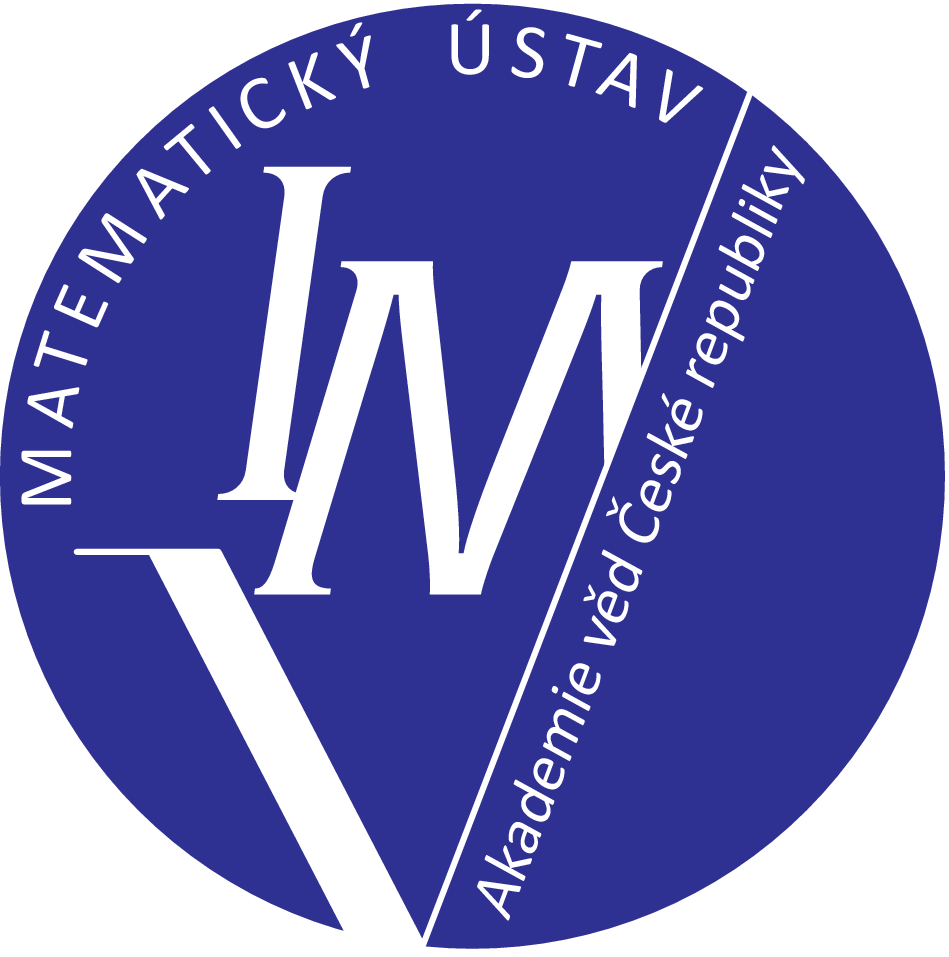
|
PANM 21
|
Aktuálně
- 31. 3.: zveřejněn sborník konference
(v zaslaném mailu byl pak překlep ohledně konání příštího PANM, PANM 22 je plánováno na červen 2024) - 7. 7.: přidána šablona a další informace ke sborníku; přidány prezentace zvaných řečníků
- 22. 6.: přidána konferenční fotografie
- 10. 6.: aktualizován program, zvěřejněna kniha abstraktů a seznam účastníků (viz níže Materiály semináře)
- 30. 5.: přijaty všechny účastnické poplatky, doklady o zaplacení předáme na začátku PANM
- 17. 5.: zveřejněn program, přidány informace k dopravě (viz sekce Místo konání a ubytování) a k posterům (viz sekce Program)
Materiály semináře
Vytištěné (dvoustranné) verze těchto dokumentů budou účastníkům rozdávány při registraci.Zaměření semináře
Problematika numerických metod, především- teoretické i praktické aspekty numerické matematiky
- algoritmizace a počítačová realizace metod
- matematické modelování a vědeckotechnické výpočty
- paralelní algoritmy a výpočty na paralelních architekturách
Jako tradičně bude po semináři vydán recenzovaný sborník, kam mohou účastníci semináře zaslat své příspěvky.
Místo konání a ubytování
Hotel Merkur, Jablonec nad Nisouinformace k dopravě (klikněte pro zobrazení)
Hotel Merkur se nachází v centru Jablonce nad Nisou, v dochozí vzdálenosti od autobusového nádraží i železničního nádraží (zhruba 5-10 minut chůze).
Pro dopravu z Prahy doporučujeme autobus z Černého Mostu (konečná metra linky B); doba jízdy je přibližně hodinu a čtvrt a autobusy odjíždí každou hodinu. Jízdenky lze zakoupit přímo u řidiče, nicméně je vhodnější jízdenku s místenkou koupit v předstihu.
Cestující vlastním automobilem upozorňujeme, že hotel bohužel (navzdory informaci na svém webu) nemá k dispozici krytá nebo hlídaná parkovací stání. Parkování zdarma je nicméně možné nedaleko, viz odkaz na mapu.
Program
Program v pdfPříjezd účastníků v neděli 19. 6. odpoledne a neformální zahájení semináře tentýž den večer. Odjezd v pátek 24. 6. po obědě. Do programu budou zařazeny zvané přednášky (60 min.), krátká sdělení (25 min.) a postery. Jednacím jazykem bude čeština, slovenština nebo angličtina. Promítané materiály mohou být v angličtině ve všech případech.
informace k posterům
Posterová sekce bude probíhat v přednáškové místnosti. Na mobilní dělící stěnu bude možné přilepit 8 - 10 posterů (materiál na přilepení zajistíme). Zbývající postery budou, tak jak bývá na PANM obvyklé, položeny na stolech v místnosti. Kromě posteru je samozřejmě na stůl možné přidat i notebook s videem či interaktivní aplikací a podobně. V případě nejasností, dotazů, či požadavků neváhejte kontaktovat organizátory.Zvaní řečníci
- Monika Balázsová - Discontinuous Galerkin method for problems in time-depend domains – theory and applications [prezentace]
abstrakt
Most of the theoretical mathematical results on the solvability and numerical analysis of nonstationary partial differential equations are obtained under the assumption that a space domain is independent of time. However, problems in time-dependent domains are important in a number of areas of science and technology. This is particularly the case of fluid-structure interaction problems, when the flow is solved in a domain deformed due to the coupling with an elastic structure. There are various approaches to the solution of problems in time-dependent domains, very popular technique is the arbitrary Lagrangian-Eulerian (ALE) method. In this talk we present an ALE version of the space-time discontinuous Galerkin method, which is based on piecewise polynomial approximations over finite element meshes, in general discontinuous on interfaces between neighbouring elements. We show that the proposed method is numerically unconditionally stable and demonstrate its robustness on a numerical solution of the nonlinear elasticity benchmark problem. The developed method is also applied to the numerical simulation of air flow in a simplified model of human vocal tract and flow induced vocal folds vibrations. - Jan Březina - Bayesovská inverze pro transportní vlastnosti zóny porušení v důsledku ražby [prezentace]
abstrakt
Zóna porušení (EDZ) v okolí chodeb úložiště radioaktivního odpadu je potencionální transportní cestou kontaminace do významných poruchových zón což by mělo vliv na celkovou bezpečnost úložiště. Parametry transportního modelu (zejména porozita a permeabilita) jsou významně ovlivněny změnami napětí při ražbě a následně při zatopení chodeb úložiště. Představíme nelineární poroelastický model vzniku a dalšího vývoje EDZ. Pro experimentální data z kontinuálního měření pórových tlaků během ražby určíme pomocí Bayesovské inverze aposteriorní rozdělení pro parametry poroelastického modelu. Zejména získáme rozdělení pro permeabilitu a porozitu, která použijeme pro sestavení stochastického modelu transportu kontaminace podél EDZ. Nakonec aplikujeme víceúrovňovou metodu Monte Carlo pro aproximaci hustoty pravděpodobnosti indikátoru bezpečnosti odvozeného od hodnot koncentrace kontaminantu. -
Pavel Krejčí - Michal Kuráž - Mathematical modeling of hydrodynamical processes in porous medium under phase changes due evaporation and freezing/melting [prezentace]
abstrakt
Mathematical modeling in soil system sciences typically covers three distinct fields: hydrodynamics, thermodynamics and transport of solutes. A very typical property of all hydrodynamical processes in soils is an extremely low velocity of the liquid motion, flow regime is typically laminar. Due to low kinetic forces the flow field is significantly affected by osmotic and temperature gradient. Further, the flow area is scattered into microscopic pore paths, where phase changes such as evapotranspiration and ice crystallization can significantly affect local porous medium hydraulic properties. Setting up boundary conditions representing meteorological conditions is again nontrivial. In this talk it will be explained how to adapt the governing flow equation for describing flow processes together with liquid phase changes due freezing/melting and evapotranspiration. A special attention will be given to real-world application of smart farming system developed and installed on vineyards Finca Ecohumus, San Juan, Argentina. - Karol Mikula - Mathematical models and computational algorithms for 3D and 4D image processing in developmental biology and medicine
abstrakt
We present mathematical models and numerical algorithms based on nonlinear advection-diffusion equations used for image filtering, segmentation and tracking in a large-scale 3D+time laser scanning microscopy images leading to automated reconstruction of the cell lineage tree during the first hours of embryogenesis. To achieve that goal, we discretize the nonlinear partial differential equations by the finite volume method, natural to image processing applications, and develop efficient and stable numerical schemes suitable for massively parallel computer architecture. This is a common work with colleagues from Institute of Developmental Biology CNRS and Ecole Polytechnique, Paris, France and University of Bologna, Italy.. - Ivan Němec - New Methods in Collision of Bodies Analysis [prezentace (.pptx)]
abstrakt
joint work with Jiří Vala, Hynek Stekbauer, Michal Jedlička, Daniel Burkart
The widely used method for solution of impacts of bodies, called the penalty method, is based on the contact force proportional to the length of the interpenetration of bodies. This method is regarded as unsatisfactory by the authors of this contribution, because of a inaccurate fulfillment of the energy conservation law and violation of the natural demand of impenetrability of bodies. Two new methods for the solution of impacts of bodies, suggested by the authors, fulfill these demands exactly, or approximately, but much better than the penalty method. The energy method exactly fulfills the conservation of energy law and the kinematic method exactly fulfills the condition of impenetrability of bodies. Both of these methods are superior in comparison with the penalty method, which is demonstrated by the results of several numerical examples. - Stefano Pozza - A Lanczos-like method for non-autonomous linear ordinary differential equations [prezentace]
abstrakt
The time-ordered exponential (TOE) is the solution of a system of first-order linear differential equations with generally non-constant coefficients. Its approximation is crucial in many applications, for instance, in nuclear magnetic resonance (NMR), where it appears as the solution of the Schrödinger equation. In NMR applications, simulating particle dynamics is of great importance. Unfortunately, modeling a large number of particles leads to huge ODE systems whose numerical solution is still a challenge.
Two new approaches for TOE approximation have been introduced in recent years: the path-sum and the *-Lanczos methods. They both rely on a convolution-like product, the so-called *-product. We will show an accurate approximation of such a product and why this may be the key to the efficient numerical computation of TOEs. - Petr Tichý - On error estimation in the conjugate gradient method [prezentace]
abstrakt
The (preconditioned) conjugate gradient (P)CG method is the iterative method of choice for solving linear algebraic systems Ax=b with a real symmetric positive definite matrix A. To solve the underlying practical problems efficiently, it is important to know when to stop the CG iterations. Stopping criteria are application dependent. The relevant quantities for monitoring the quality of the approximate solution x_k are, e.g., the A-norm of the error, the Euclidean norm of the error, the normwise backward error, or the residual norm. Some of the above mentioned quantities cannot be easily evaluated, however, they can be estimated. In this presentation, we recall known results and then concentrate on estimating the A-norm of the error. Our aim is to improve the accuracy of the estimates using information from d forthcoming CG iterations. We suggest a heuristic strategy for the adaptive choice of d such that the relative accuracy of the resulting estimates is within a prescribed tolerance. Numerical experiments demonstrate that the suggested strategy is efficient and robust.
Účastnický poplatek
9000,- Kč (studenti 8000,- Kč)Zahrnuje účast na přednáškách, ubytování na dvou nebo třílůžkovém pokoji s plnou penzí, sborník a další materiály semináře, občerstvení během přestávek a společenský program. V případě plánovaného zkrácení pobytu je možná sleva.
Sborník
Tradiční recenzovaný sborník příspěvků je k dispozici zde. V nejbližší době bude zveřejněn v České digitální matematické knihovně (články budou volně přístupné, tzv. open access) a rovněž v tištěné podobě.Důležité termíny
| 18. 3. 2022 | registrace účastníků, včetně krátkého abstraktu |
| 8. 4. 2022 | organizátoři potvrdí přijetí příspěvku |
| 13. 5. 2022 | splatnost účastnického poplatku |
| 19.-24. 6. 2022 | PANM 21 |
| 30. 9. 2022 | zaslání příspěvku do sborníku |
Organizace
Seminář organizuje Matematický ústav AV ČR, v. v. i., pod záštitou národní sítě pro aplikovanou a průmyslovou matematiku EU-MATHS-IN.cz.Organizační výbor:
J. Chleboun, P. Kůs, J. Papež, P. Přikryl, M. Rozložník, K. Segeth, J. Šístek, T. Vejchodský
Sekretariát konference: H. Bílková, J. Papež, J. Šístek
Kontakt
e-mail: panm@math.cas.czOdkazy na minulé semináře
PANM 20, PANM 19, PANM 18, PANM 17, PANM 16, PANM 15, PANM 14, PANM 13

|

|